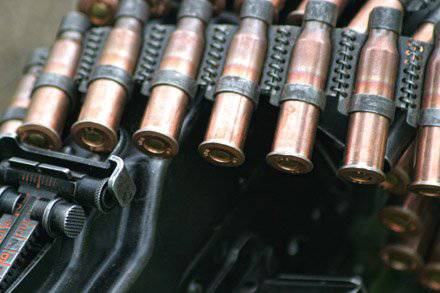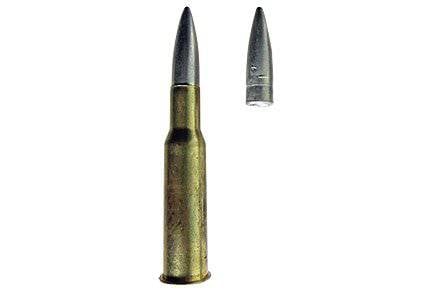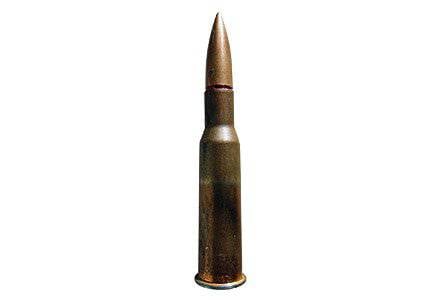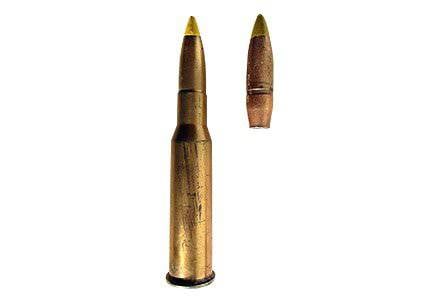7,62 mm rifle and machine gun cartridges

7,62-mm rifle (rifle-machine-gun) Russian cartridge is one of the most "ancient" long-livers among other cartridges for rifle armsSince the first domestic rifle cartridge with a shell bullet and smokeless powder was created for the 3-linear magazine rifle mod. 1891, the system of S. I. Mosin.
16 April 1891, by the highest decree of Emperor Alexander III (order according to GAU No. 124 of 11 in May 1891 of the year), the new 3 linear rifle cartridge of the 3 model of the year was adopted by the Russian army along with the 1891 linear magazine rifle and cartridge holder.

3-x linear (7,62-mm) rifle cartridge of the year with a light bullet of the 1908 model of the year in a nickel silver shell
After the end of the Civil War, military experts again addressed the issue of upgrading the main 7,62-mm rifle and machine-gun cartridge. In 1930, the Red Army adopted a whole range of new 7,62-mm rifle and machine-gun cartridges with an improved light bullet of the 1908 of the year and with special-purpose bullets ("D", "B-30", "T-30"). In 1930 – 1940-s, new 7,62-mm special rifle bullets are developed for solving special problems: “B-32”, “BT-32”, “BZT”, “3”, “P”, “BS-40”, "T-46", and in 1938, the bullets "3" and "P" replace the bullet "PZ", and the bullet "BZT" - a bullet "ЗБ-46".
Sleeves
If 7,62-mm rifle-and-machine-gun cartridges of 1891 – 1931 production were produced only with a brass sleeve, then already in 1932, they received upgraded sleeves — brass and even cheaper — bimetallic (i.e., made of low-carbon clad tampacom steel). The bimetallic and brass sleeves of the 7,62-mm rifle-and-machine-gun cartridge of the 1930 sample were almost the same and had a Dulce shortened from 11,0 to 9,4. Some changes were made to the geometry of the sleeve: the most notable of them was the change in the profile of the bottom of the sleeve from a hemispherical one, which caused delays in the automatic operation of Maxim machine guns to Maximus trapezoidal; In addition, the slope of the sleeve liner now had no curvature. The replacement of brass with a bimetal for the manufacture of cartridge cases before the Great Patriotic War provided a tremendous savings of non-ferrous metals - up to 96%, which previously went to the manufacture of cartridges. So, for example, if it were not possible to make the transition to bimetal, then in order to carry out the program for the production of rifle cartridges in 1940, 18 000 tons of brass and 4 800 tons of nickel silver would be required. So, only in 1940, all the Soviet ammunition factories produced approximately 250 million 7,62-mm rifle and machine-gun cartridges with a bimetallic sleeve. The ability to produce on a massive scale the most widespread small arms cartridges with cheap steel sleeves was a major technological breakthrough and became one of the greatest achievements of the Soviet defense industry in the prewar period.
During the Great Patriotic War, a significant part of the 7,62-mm rifle and machine-gun cartridges was produced using a simplified technology, in sleeves without a protective tompac coating (the so-called "surrogative"). These sleeves were made of cold-rolled ПХNUMX ЮА steel without a protective coating and were not protected from corrosion by any means, they were left with only a layer of technological contact copper coating. From the beginning of the 18, a significant part of the gross rifle cartridges with light “L” and heavy “D” bullets was produced in “surrogative” uncoated sleeves. After the war, the release of these cartridges was discontinued.
At the end of the 1950-s, the sleeves of the 7,62-mm rifle cartridge underwent a major new upgrade - replacing the protective anti-corrosion coating from tombac to varnish. Despite the complexity of this technology, its introduction turned out to be very profitable, since it made it possible to almost completely eliminate the consumption of scarce nonferrous metals.
Production of 7,62-mm rifle and machine-gun cartridges with steel lacquered sleeves was established in 1960-ies initially at the Ulyanovsk engineering plant, where during the war years there was a wealth of experience in the production of 7,62-mm rifle cartridges with sleeves without bimetallic coating, and then Barnaul machine tool factory. Currently, in Russia, combat 7,62-mm rifle and commercial rifle cartridges are available with three types of shells:
- steel lacquered - 7,62-mm rifle-and-machine-gun and commercial 7,62-mm rifle cartridges — at the Barnaul Machine-Tool Building Plant;
- bimetallic - combat 7,62-mm rifle-and-machine-gun and commercial 7,62-mm rifle cartridges - at the Novosibirsk plant of low-voltage equipment;
- brass - only 7,62-mm sport cartridges “Extra” and their hunting modifications - at the Novosibirsk plant of low-voltage equipment.
BULLET arr. 1891 of the year
The rifle cartridge bullet obr. 1891, was a cylindrical shape, with a spherical head. This form of bullet provided it with sufficient penetrative and damaging properties at that time, a high lateral load, contributed to good stability in flight, and as a result - high accuracy of hits at significant distances. If we consider that there were no machine guns in the army at the end of the 19th century, and shooting at volleys was recommended for defeating group targets at long ranges, this factor was of no small importance. The rifle bullet weight of the 1891 of the year was 13,73 g, length of 30,48 mm, maximum diameter of 0,306 – 308 inch (7,77 – 7,82 mm). The bullet shell was made of nickel silver, representing an alloy of copper 78,5 – 80,5% and nickel 19,5 – 21,5%. The core of a rifle bullet, 1891, was made of lead with the addition of antimony). When firing from an infantry rifle obr. 1891, the bullet developed the initial speed 615 – 620 m. From a distance of 50 steps, she punched 16 – 35 one-inch boards. The standard shield of field artillery of that time from armor 3,5 mm thick bullet sample. 1891 year punched from 150 m distance. At the end of the nineteenth century, a similar design of an infantry rifle bullet was common in most countries of the world.
LIGHT BULLET arr. 1908 of the year
Already in 1894, the chairman of the test committee of the Okhta powder factory, G. P. Kisnemsky, proposed a new light-pointed rifle bullet with an ogival shape for the 3-linear rifle cartridge of the 1891 model, but then this proposal was not further developed.
After significant research and development work in 1908, the new 7,62-mm light rifle bullet with 9,6 g mass was adopted by the Russian army. The new bullet increased the diameter of its leading part to 0,310 – 0,312 inches (7,84 – 7,92 mm), and also increased the thickness of the bullet shell from 0,3 to 0,51 mm, and the depth of the bullet in the sleeve decreased from 6,9 to 5,0 mm. The shell of the new bullet remained melkhiorovoy, and the core - from an alloy of lead with antimony. A knurled knurling appeared on the bullet for better fixing it in the cartridge case when assembling the cartridge, and in the tail section of the bullet - a deepening of conical shape for expanding it with powder gases and improving the obturation, which was especially important when shooting with worn rifles. In addition, the recess in the bottom part of the bullet slightly moved the center of gravity of the bullet forward, which improved the dispersion characteristics and also made it possible to compensate for the temperature expansion of the barrel and to maintain the accuracy characteristics in acceptable limits. The new bullet penetration capacity has increased significantly. So, a pointed bullet pierced a steel shield 5 mm thick at a distance of 200 steps, while a blunt bullet obj.1891 year punched a shield at a distance of only 25 steps. Although when shooting at a wooden monolith at a distance of 400 m, a pointed bullet penetrated into it to a depth of 450 mm, the standard blunt-pointed bullet - at 800 mm. The smaller penetration ability of pointed-pointed bullets when firing at a wooden monolith is due to their severe deformation when a wooden obstacle is encountered at a short range. Some deterioration in the accuracy of the battlefield of the new light rifle bullet was considered to be not decisive, since the Russian-Japanese war of 1904 – 1905 had the main part of the clashes at medium (up to 800) range, and a significant difference in accuracy was approximately with 2000 steps).
LIGHT BULLET "L" arr. 1908 / 30's
In the Soviet Union at the end of the 1920-ies, due to the significant cost of nickel silver used to manufacture bullet shells, serious research was carried out to replace it. Hot rolled low carbon steel turned out to be the most suitable material for such a replacement. For better rust preservation, as well as for good bullet sliding along the bore, the steel shell was covered with a LT-90 tampaca layer (alloy from 89 – 91% copper and 9 – 11% zinc). Despite the fact that Melchior was the most optimal material for bullet casings, and steel in this respect was losing to it, all its disadvantages outweighed the economic advantages obtained by using steel as a material for pulley casings. This was especially important when mass production of ammunition - billions of pieces. In addition, in the course of testing bullets in steel shells, it turned out that the accuracy of their shooting was somewhat better than that of bullets in a nickel silver shell. This was explained by the greater rigidity of the steel shell, which better kept the bullet in the grooves.
The sheath of the modernized bullet was made of bimetal (flat rolled products of mild steel 11 KP, covered on both sides with tmpak LT-90). In 1930, the modernized light rifle bullet was put into service under the name "7,62-mm light bullet" L "of the 1908 / 30 years." The leading part of the upgraded light bullet received a small taper with a maximum diameter at the bottom cut. Fastening of the bullet in the sleeve began to crimp Dultsev flute in the form of a continuous smooth annular knurling on the leading part of the shell. The core of the light rifle bullet of the 1908 / 30 series was made of lead with a high content of antimony. The mass of the bimetallic shell of the upgraded light bullet was 2,24 g, the lead core was 7,36 g. 7,62-mm rifle-and-machine-gun cartridges with a light bullet, 1908 / 30's, were intended for firing from rifles, carbines and light machine guns, but could also be used for firing from machine guns. Cartridges with a bullet with a nickel silver shell received the designation "7,62 L Ch" (GAU index - 57-H-221 - cartridge with a light bullet L with a Melchior shell and brass sleeve (supplied in cages) and "7,62 L ch" (index - 57- H-321 - cartridge with a light bullet L with a nickel silver sheath and brass sleeve (without clips), and for cartridges with a bullet with a steel sheath “7,62 L ch” (57-H-222 index - cartridge with a light bullet L with a bimetallic shell and brass sleeve (supplied in cage) and "7,62 L ch" (index 57-H-322 - cartridge with a light bullet L with bimetallic shell points and brass sleeves), respectively, without clips. Cartridges with a light bullet L with a bimetallic shell and a bimetallic sleeve (supplied in the clips) were designated "7,62 L gzh" (index 57-H-223), and cartridges with a light bullet L with a bimetallic shell and bimetallic sleeve "7,62 L GJ" (index 57-H-323 - without clips).
Production of the 7,62-mm light rifle bullet of the 1908 / 30 years ended only in 1953, although the rifle cartridges with the “L” bullet were in supply in the Soviet Armed Forces until the beginning of the 1970's, which confirms its high combat and technological qualities laid back in the early twentieth century.
EASY BULLET WITH LPS STEEL HEART
New work on the creation of a new bullet instead of an easy “L” bullet obr. 1908 / 30 of the year began at the NIIPSVO test site in the middle of the 1930-s. The relevance of such work was due to the need to reduce the cost of manufacturing bullets of gross 7,62-mm rifle and machine-gun cartridge. It was possible to significantly reduce the cost of a bullet due to the introduction of a steel core made of soft low-grade steel into its structure, which provided significant (more than 75%) savings of scarce and expensive lead. The experiments were carried out on a number of ammunition factories for several years. In the course of the work, several variants of such t. "Surrogate" bullets - light and heavy. However, these works before the war were not completed. Since 1944 in the Soviet Union, most of the work on creating small arms ammunition was carried out at the Central Scientific Research Institute of Precision Engineering - TsNIITOCHMash (NII-44, NII-61) near the city of Klimovsk, including the creation of a new rifle cartridge cartridge. easy bullet.

7,62-mm rifle and machine-gun cartridge with LPS bullet
The steel core rifle bullet was developed only after the end of World War II, when the technology of core stamping was mastered. From 1948 to 1951 for a year, B. V. Semin (SRI-61) K. V. Smekayev (Plant No. 3) have been actively working on designing a new bullet to replace the “L” and “D” bullets. These works were completed in 1953, with the creation of a new 7,62-mm rifle cartridge with an “LPS” bullet (a light bullet surrogative, later this abbreviation began to be interpreted as a light bullet with a steel core). Thus, with the adoption of the LPS bullet cartridge for the Soviet Army, the third modernization of the 7,62-mm rifle cartridge was completed. The “LPS” light bullet cartridge with a steel core and a bimetallic sleeve (supplied in cages) received the designation “7,62 LPS GJ” (GAU index - 57-H-223 С); delivered without clips - "7,62 LPS gzh" (GAU index - 57-H-323 C); and the “LPS” light bullet cartridge with a steel core and a steel sleeve is “7,62 LPS gf” (57-H-223 С-01 index). The “LPS” bullet provided significant savings in lead and had a greater breakdown effect compared to “L” and “D” bullets. The “LPS” bullet with a mass of 9,6 g had a bimetallic casing (made of 11 mild steel KP strip steel coated on both sides with an LXNXX grade tarpacom) steel core.
The external ballistic characteristics of the LPS bullet were maximally unified with the L bullet, which was one of the items of the technical assignment for its development. In the army, cartridges with these types of bullets were considered interchangeable, which made it possible to use the marking of the sights of almost all previously adopted weapons of small-arms under the 7,62-mm rifle cartridge for firing cartridges with an LPS bullet. Although there is some difference in the ballistics of the “LPS” bullet and the “L” light bullet, the 1908 still has the year, which is explained by the difference in the shape of the “LPS” and “L” bullets. So, at a distance of 300 m, the speed of the “LPS” bullet on 10 m / s is higher than that of the light bullet “L”, which is about 6%, and this difference is manifested only at significant firing ranges. It has no practical value for the average army shooter. Nevertheless, the sniper using cartridges with the LPS bullet during rifle shooting of the 1891 / 30 gg. or carbines obr. 1938 year / 1944 year for a distance above 300 m using standard sights, this difference in ballistics bullets should be taken into account. Soviet models of small arms for 7,62-mm rifle and machine-gun cartridge, developed and put into service after the 1953 year, had markup of sights only under the bullet "LPS".
7,62-mm rifle-machine gun cartridge with a bullet "LPS" is used for shooting from a magazine rifle mod. 1891/30; carbines model 1938 and model 1944; light machine guns DP / DPM; RP-46; heavy machine guns SG-43 / SGM; unified PK / PKM machine guns, tank PKT and others.
The adoption of LPS bullet cartridges along with a significant economic effect made it possible to reduce the range of rifle cartridges produced by two samples (cartridges with “D” and “L” bullets were removed from production).
At the beginning of the XXI century, rifle-and-machine-gun cartridges with LPS bullets are gross rifle cartridges, which carry out most of the firing tasks, shooting, exercises. Production of 7,62-mm rifle-and-machine-gun cartridges with LPS bullets was discontinued in 1989 year, but large stocks of cartridges of this nomenclature are still stored in the warehouses and arsenals of the Ministry of Defense. Subsequently, on the basis of the design of the LPS bullet, a whole series of new rifle cartridges with bullets of enhanced tractive action was developed.
HEAVY BULLET "D" arr. 1930 of the year
In 1930-ies of the 20th century, in the armies of many countries of the world, including in the Soviet Union, the concept was developed, according to which heavy machine guns had to fight with enemy manpower at distances over 1000 m, including shooting with closed firing positions over the head of his troops. Long range shooting made special demands not only on the weapon itself, but also on its ammunition. This required a cartridge with a heavy bullet.
In order to develop its own model of a heavy bullet in the late 1920-s in the USSR, extensive tests of rifle cartridges with various samples of heavy bullets of improved form, both in-house and foreign, including rifle cartridges .30 – 06 (7,62- mm) Springfield M 1 with a heavy bullet.

7,62-mm rifle and machine-gun cartridge with a heavy bullet "D" arr. 1930 of the year
As a result, as it happened more than once in our stories, it was decided to develop a domestic 7,62-mm rifle cartridge with a heavy bullet, based on a foreign (in this case - American) sample of a heavy bullet from the XXUMX of the year. The heavy bullet to the rifle cartridge was developed by renowned Soviet small arms designers A. A. Smirnsky and Dobrzhansky. Heavy bullet cartridge "D" (D - long-range) was adopted by the Red Army in the year 1925 and received the designation "1930 D ch" (GAU index - 7,62-D-57 - for cartridges with a brass sleeve) and 422 D GJ (Index - 7,62-D-57 for cartridges with a heavy (long-range) bullet D and a bimetallic sleeve. The bullet had a mass - 423 g and initial speed 11,8 m / s. Cartridges with a heavy bullet were intended mainly for firing from easel machine guns (considered machine guns cartridges), but it was allowed to use them for firing rifles, carbines and light machine guns sightings with the appropriate amendments to the sights. The heavy bullet of the 800 of the year consisted of a steel, clad on both sides tompakom (bimetallic) shell of cold-rolled clad mild steel 1930 KP with a core of lead pressed into it with a mass - 11 g. light bullet “D” bullet was distinguished by its elongation and shape (at the bottom it had a surface with a truncated cone). The bullet was fastened in a sleeve case by crimping the upper cut of the socket in an annular groove (flute) rolling on the leading part of the bullet shell. The top of the bullet "D" was painted in yellow.
The increased, compared with the light bullet "L", the weight and lateral load of a heavy bullet had a positive effect on the increase in its flight range, accuracy and the probability of hitting the target. In spite of the fact that the accuracy standard for cartridges with a heavy “D” bullet was the same as for cartridges with a “L” light bullet (R50 == 10,5 cm on 300 m), at long range the accuracy of shooting a heavy bullet was better than a bullet of smaller mass. The advantage of flattening the trajectory of a heavy bullet to a light one began to affect the 400 distance m and increased with increasing distance to the target. Already at about 600 distance m, the heavy bullet “overtook” the light one, while maintaining greater speed and, therefore, had more energy and better ballistics. The most effective range of firing ammunition with a heavy “D” bullet. 1930 of the year was approximately 850 m. At this range, the probability of hitting a single target with a height of 30 cm is 10,8%. The maximum range of a heavy bullet "D" obr.1930 year when firing a rifle obr.1891 / 30 gg. 5100 m. Heavy bullet "D" pierced the standard army helmet at a distance of 1400 m, while the slaughter action on an unprotected target was maintained at a distance of up to 4500 m. The maximum range of the bullet when firing from the Maxim machine gun was 5000 m. For shooting cartridges with a heavy D bullet on the Maxim machine guns of the MN machine guns upgraded in the 1930 year, and subsequently SG Goryunov machine gun machine gun mod. The 1943 of the year on the aiming slats had two aiming scales - separately for a light bullet (with the designation - L) and separately for a heavy bullet (with the designation - T).
From the first days of the Great Patriotic War it became obvious that shooting from heavy machine guns at long ranges, and even more so from closed positions, was practically never used anywhere. At the same time, rifle cartridges with a heavy “D” bullet were produced during the entire Great Patriotic War, they were used to solve ordinary firing tasks along with the “L” light bullet cartridges. During the war, cartridges with heavy bullets were used for firing from sniper rifles obr.1891 / 30. and SVT-40. When firing these cartridges required amending the installation of an optical sight.
The “D” bullet cartridges were produced in 1941 – 1944. with brass, bimetallic and steel without coating sleeves, and from 1944 of the year - only with bimetallic and steel without coating sleeves. In 1953, rifle cartridges with a heavy “D” bullet of the 1930 year were discontinued and excluded from the ammunition of heavy machine guns, but for a long time, up to the middle of the 1970's, they were in service. Their significant reserves were used for training shooting. Subsequently, the special properties of the heavy “D” bullet of the XXUMX of the year (in particular, its successful aerodynamic shape) were useful to Soviet gunsmith designers as the basis for developing other types of bullets to a rifle cartridge.
- Sergey Monetchikov
- http://www.bratishka.ru
- Photo from the archive of the author
Information